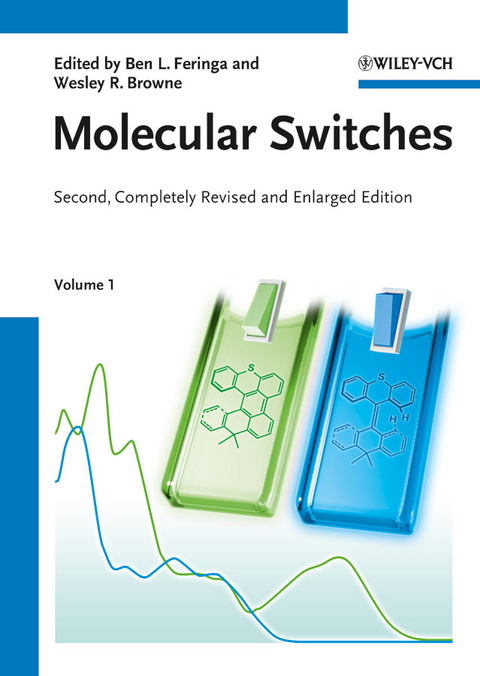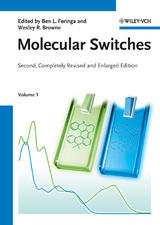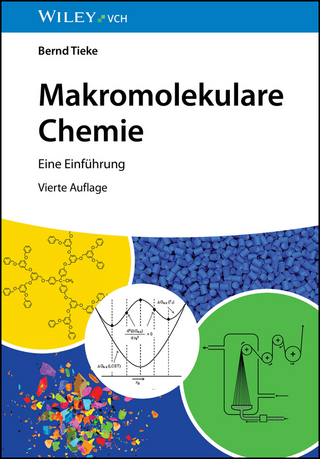Molecular Switches
Wiley-VCH (Verlag)
978-3-527-31365-5 (ISBN)
- Titel ist leider vergriffen;
keine Neuauflage - Artikel merken
Täglich benutzen wir Schalter, um strombetriebene Geräte an- und abzuschalten und kein Compuer würde ohne sie funktionieren. Nach den gleichen Prinzipien funktionieren auch molekulare Schalter, die unter dem Einfluß ihrer Umwelt zwischen zwei definierten Zuständen wechseln können. Im Gegensatz zu den gewöhnlichen Schaltern sind molekulare Schalter aber außerordentlich klein und ihre Anwendung in der Nanotechnologie, Biomedizin und im Computerchipdesign öffnet neue Horizonte.Im vorliegenden Zweibänder berichten Herausgeber und Autoren über molekulare Schalter aus Katenanen und Rotaxanen, Fulgiden, Flüssigkristallen und Polypeptiden. Die Bandbreite der behandelten Themen reicht von chiroptischen Schaltern über multifunktionale Systeme bis hin zu molekularen logischen Schaltungen.Chemiker und Materialwissenschaftler in Industrie und Hochschule, die sich für einen der innovativsten Bereiche ihrer Wissenschaft interessieren, werden dieses Buch mit Gewinn lesen!
Ben L. Feringa is the Distinguished Jacobus Van't Hoff Professor of Organic Chemistry at the University of Groningen, where he is also the director of the Stratingh Institute for Chemistry. His research career spans four decades and covers topics as diverse as materials science, total synthesis, homogeneous catalysis and of course molecular photochemistry with chirality as the core guiding theme in his research career which includes over 500 scientific papers published to date. For his contributions to research he has received numerous awards including the Spinoza award of the Netherlands Organization for Scientific research and the ACS Norrish Award and is a member of the Royal Netherlands Academy of Sciences and Honorary Foreign member of the National Academy of Sciences (USA). He was appointed recently as an Academy Professor of the Royal Netherlands Academy of Sciences. Wesley R. Browne is Assistant Professor of Molecular Systems & Interfaces at the University of Groningen. He completed his undergraduate and doctoral studies (under Prof. Han Vos) at Dublin City University, Ireland in 2002 for which he was awarded the Prize for Young Chemists by the Royal Irish Academy, before taking up a postdoctoral position first in Queens University Belfast (NI, under Prof. John McGarvey) and then at the University of Groningen. In 2007 he was awarded a VIDI fellowship from the Netherlands Organization for Scientific research and in 2008 was appointed to his present position as Assistant Professor. His research interests are diverse and include electrochemistry and Raman spectroscopy applied to both studying mechanisms in oxidation catalysis and to the photochemistry of molecular materials and polymers. He has published over 70 research papers to date.
VOLUME ONE
PART I: Molecular Switching
MULTIFUNCTIONAL DIARYLETHENES
Introduction
Electrochemical Ring-Closing and Ring-Opening of DTEs
Using Dithienylethenes to Modulate How Chemicals React or Interact with Others
Gated Photochromism
Reactivity-Gated Photochromism Using the Functional Group Effect
Conclusion
PHOTOSWITCHABLE MOLECULAR SYSTEMS BASED ON SPIROPYRANS AND SPIROOXAZINES
Introduction
Mechanism of the Photochromic Reaction
Switching of Physical Properties and Biological Activities via Photochromic Rearrangements of Functionalized Spiropyrans and Spirooxazines
Spiropyrans and Spirooxazines as Photodynamic Sensors for Metal Ions
Modulation of the Intramolecular Energy-Transfer Processes in SP/SPO-Containing Transition-Metal Complexes
Spiropyran-Containing Photoresponsive Polymers
Spiropyran/Spirooxazine-Containing Biphotochromic Systems
Concluding Remarks
FULGIDES AND RELATED COMPOUNDS
Introduction - Fulgides
Review Dealing with Fulgides
Introduction of New Fulgides towards Molecular Switches
Photophysics of Molecular Switches
Towards Optical Recording
Understanding of Molecular Structures from Calculations
Development of Photochromic Switches Closely Related to Fulgides
Perspectives of Research with Fulgides
TRANSITION METAL-COMPLEXED CATENANES AND ROTAXANES AS MOLECULAR MACHINE PROTOTYPES
Introduction
Copper-Complexed [2]Catenanes in Motion: The Archetypes
Fighting the Kinetic Inertness of the First Copper-Based Machines; Fast-Moving Pirouetting Rotaxanes
Molecular Motions Driven by Chemical Reactions - Use of a Chemical Reaction to Induce the Concentration/Stretching Process of a Muscle-Like Rotaxane Dimer
Electrochemically Controlled Intramolecular Motion within a Heterodinuclear Bismacrocycle Transition-Metal Complex
Ru(III)-Complexes as Light-Driven Molecular Machine Prototypes
Conclusion and Prospective
CHIROPTICAL MOLECULAR SWITCHES
Introduction
Molecular Switching
Chiral Fulgides
Light-Driven Molecular Rotary Motors
Liquid Crystals
Gels
Conclusions and Perspectives
MULTISTATE/MULTIFUNCTIONAL MOLECULAR-LEVEL SYSTEMS: PHOTOCHROMIC FLAVYLIUM COMPOUNDS
Introduction
Energy Stimulation
Photochromic Systems
Bistable and Multistable Systems
Nature of the Species Involved in the Chemistry of Flavylium Compounds
Thermal Reactions of the 4'-Methoxyflavylium Ion
Flavylium Ions with OH Substituents
Flavylium Ions with Other Substituents
Energy-Level Diagrams
Chemical Process Networks
Conclusions
NUCLEIC-ACID-BASED SWITCHES
Molecular Switches Made from DNA and RNA
Switchable Ribozymes
Regulatory RNA Molecules
Sensor Applications
DNA Computing
DNA Machines
Switchable Molecular Networks and Materials
Conclusion and Outlook
PART II: Switching in Containers, Polymers and Channels
SWITCHING PROCESSES IN CAVITANDS, CONTAINERS AND CAPUSLES
Introduction
Switchable Covalently Constructed Cavitands and Container Molecules
H-Bonded Molecular Capsules
Assembly and Disassembly of Metal-Ion-Coordination Cages
Conclusions
CYCLODEXTRIN-BASED SWITCHES
Introduction
In and Out Switching
Back and Forth Switching
Displacement Switching
Coordination Switching
Rearrangement Switching
Conclusion and Perspective
PHOTOSWITCHABLE POLYPEPTIDES
Photoresponsive Polypeptides
Light-Induced Conformational Transitions
Photostimulated Aggregation-Disaggregation Effects
Photoeffects in Molecular and Thin Films
Photoresponsive Polypeptide Membranes
Summary and Recent Developments
Towards More Complex Biorelated Photoswitchable Polypeptides
ION TRANSLOCATION WITHIN MULTISITE RECEPTORS
Introduction
Metal-Ion Translocation: Changing Metal's Oxidation State
Metal-Ion Translocation: Changing through a pH Variation the Coordinating Properties of One Receptor's Compartment
The Simultaneous Translocation of Two Metal Ions
Redox-Driven Anion Translocation
Anion Swapping in a Heteroditopic Receptor, Driven by a Concentration Gradient
Conclusions and Perspectives: Further Types of Molecular Machines?
VOLUME TWO
OPTICALLY INDUCED PROCESSES IN AZOPOLYMERS
Introduction
Azoaromatic Compounds: Synthesis, Functionality and Film Fabrication
Applications
Final Remarks and Prospects
PHOTORESPONSIVE POLYMERS
Introduction
Photo-Orientation by Photoisomerization
Photoisomerization and Photo-Orientation of Azo Dye in Films of Polymer: Molecular Interaction, Free Volume and Polymer Structural Effects
Photoisomerization Effects in Organic Nonlinear Optics: Photoassisted Poling and Depoling and Polarizability Switching
Conclusion
RESPONSIVE MOLECULAR GELS
Introduction
Chemoresponsive Gels
Physicoresponsive Gels
Conclusions
SWITCHABLE PROTEINS AND CHANNELS
Introduction
Photoswitch Characteristics
Photoswitch Incorporation
Designing Photoswitchable Proteins
Photoswitchable Enzymes
Photoswitchable Ion Channels
Future Challenges
Concluding Remarks
PART III: Molecular Switching in Logic Systems and Electronics
READING AND POWERING MOLECULAR MACHINES BY LIGHT
Introduction
Basic Concepts
Interlocked Molecular Species as Nanoscale Machines
Molecular Machines Monitored by Light
Molecular Machines Powered and Monitored by Light
Conclusion and Perspectives
PHOTOINDUCED MOTION ASSOCIATED WITH MONOLAYERS
Introduction
Background to Photoinduced Motion of Monolayers
Photoswitchable Flat Monolayers
Photoswitchable Surfaces with Controlled Roughness
Light-Guided Liquid Motion
Photoinduced Motion on Water Surface
Photoinduced Morphology and Switching at Nanometre Levels
Photoinduced Morphologies in Two-Component Systems
2D Block-Copolymer Systems
Summary
MOLECULAR LOGIC SYSTEMS
Introduction
YES Logic
NOT Logic
AND Logic
OR Logic
NAND Logic
INH Logic
NOR Logic
XOR Logic
Three-Input AND Logic
Three-Input NOR Logic
EnNOR Logic
Arithmetic and Gaming
An Application of Molecular Logic: Molecular Computational Identification (MCID)
Conclusion
ELECTRON- AND ENERGY-TRANSFER MECHANISMS FOR FLUORESCENCE MODULATION WITH PHOTOCHROMIC SWITCHES
Fluorescence
Electron Transfer
Energy Transfer
Photochromism
Fluorescence Modulation in Fluorophore-Photochrome Conjugates
Fluorescence Modulation in Nanostructured Assemblies
Fluorescence Modulation in Multilayer Constructs
Conclusions
CONDUCTANCE PROPERTIES OF SWITCHABLE MOLECULES
Introduction
Intrinsic Switches and Extrinsic Switching
Quantum Charge Transport through Molecular Junctions
Experimental Methods
Transport Studies on Switchable Molecules
Conclusions and Outlook
"This book will appeal most to organic chemists, because of the way new structures are introduced through their synthesis, but it will also provide a useful introduction for other scientists, provided they are conversant with molecular structures." (Organic and Biomolecular Chemistry)
"... a comprehensive and up-to-date insight ..." (Chemistry & Industry)
| Erscheint lt. Verlag | 27.7.2011 |
|---|---|
| Verlagsort | Weinheim |
| Sprache | englisch |
| Maße | 170 x 240 mm |
| Gewicht | 1904 g |
| Themenwelt | Naturwissenschaften ► Chemie ► Organische Chemie |
| Technik ► Maschinenbau | |
| Schlagworte | Biochemie u. Chemische Biologie • Biochemistry (Chemical Biology) • Chemie • Chemie / Organische Chemie • Chemistry • Electrochemistry • Elektrochemie • Molekularphysik • Nanomaterialien • nanomaterials • Nanotechnologie • nanotechnology • Organic Chemistry • Organische Chemie • Physical Chemistry • Physikalische Chemie • Polymer Science & Technology • Polymer Science & Technology • Polymerwissenschaft u. -technologie • Schalter |
| ISBN-10 | 3-527-31365-6 / 3527313656 |
| ISBN-13 | 978-3-527-31365-5 / 9783527313655 |
| Zustand | Neuware |
| Haben Sie eine Frage zum Produkt? |
aus dem Bereich




